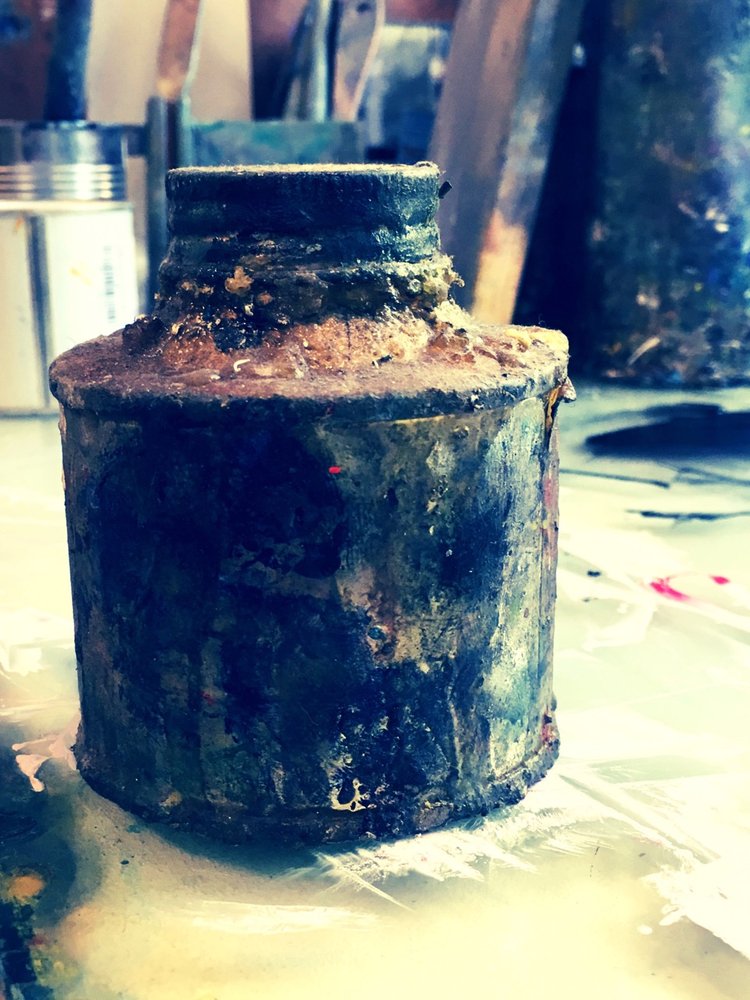Pentire Farm / National Trust
Solo Exhibition & Installation 27 - 30 October, 2016
A view of the old farm house at Pentire
These paintings take their inspiration from a life-long relationship with a short section of the North Cornwall coast. From Port Quin to Pentire, with Epphaven and Lundy Bay, Trevan, Carnweather, Com Pit and the iron age cliff castle at Rumps Point in between, this area is characterised by precipitous cliffs, rarely accessible beaches and mostly unvisited islands. All standing in exposed opposition to the relentless and untrammelled Atlantic reach.
The paintings are some distance from absolute depiction with few immediate references to actual landmarks or recognisable phenomena. They are not pure abstraction however. They are instead an almost synaesthetic response to the experience of being in landscape as opposed to merely observing it; a personal testimony to the sensation, memory, and imagination of a specific location and one's place in it.
Landscape is the matrix in which human experience is acted out. It is not just in front of us but is all encompassing; parts that we can see and sense, other parts out of reach or left behind. When thought of in these terms landscape becomes loaded with metaphorical possibilities. Cornwall, its north coast in particular, is a location where physics and metaphysics collide and combine; where the observable and the imagined seem to vie for attention.
This liminal place is defined, in part, by unmediated weather systems, Atlantic swells, tectonic upheaval and the mechanisms by which all of these combine to sculpt the landscape and one's experience of it. The coastline is also about time. Tidal strand lines mark out lunar time in wandering trails of exotic material. The waves rise, fall and advance to their own rhythm, a frequency metered out in sound and vision. Geological layers, exposed at the cliff edge, reveal pre-historic processes of unfathomable duration.
This is a location that almost demands that you stand on the outside of all of this and look out. That you contemplate what lies beyond the horizon; that you look beyond the known, beyond the immediately accessible evidence of landscape. To explore beyond the safe havens of certainty and the familiar. To become enmeshed in the various registers of time that describe this place and the processes that shape it.
A familiar characteristic of this coast are its headlands with their associated islands. These islands cut loose from the mainland by the forces of erosion and sea level change, out of sight of human gaze, and, mostly, at a rate beyond human perception. Now seemingly static and unchanging forms they stand in an ever changing and infinitely variable matrix of reflected light, colour, movement and sound. A complex matrix that is the third element in what would otherwise appear to be a simple, but poetic, duality.
“Edgeness” informs much of the experience of North Cornwall. There is a certain self- discovery to be derived from the disorientating and existentially challenging precariousness of being at this edge. Add to this the tempestuous, pressing weather and the lack of shelter from shuddering storms and this is a place of personal responsibility with little or no deferral from one's own thoughts and actions.
These paintings seek to explore this “edgeness”; the potentially vulnerable but ultimately invigorating demarcation or transition zones. The paintings can perhaps be considered to
be complexity maps that combine notions of time and experience with the more tangible phenomena and coordinates of physical space. The often bifurcated picture plain (that duality of island and headland), with its grids and vectors, represents not only the observable but also the spaces in between; the spaces at the teetering edge of awareness; the pathways that lead out to metaphysics, back to memory and inwards to the imagination.
These paintings are built up over time in multiple layers. The paint is often scraped back to reveal the substrata and then reapplied and deposited elsewhere on the painting surface. This process of layering is, perhaps, a metaphor for the way in which we accumulate memories; each layer informing and shaping the next; blended and modified echoes of what went before. The textures these layers create are akin to the interference patterns of waves as forces, past and present, cause them to reflect and diffract. Moments of clarity in a matrix of something more diffuse and fugitive.
Colour and texture are key elements in these paintings, perhaps even more important than overall structure. Colour and texture create moments within the overall picture plain that act as triggers to personal experience; colour in particular appeals to deeply personal associations. Colour and texture can of course be literal devices (blue is sky or sea, for example) but it is the use of these characteristics as ciphers that is of more interest to me. When used in a more abstract way colour and texture exploit the provocative and rebellious power of ambiguity.
Colours, carefully combined, create a harmonised and balanced space and in my view this should be a primary concern of painting. If the overall image is not resolved then perhaps the argument is lost before its even begun. Disharmony, or friction, also has its role laying down a challenge to complacency, prejudice and predisposition. These moments then act as a kind of punctuation mark, altering the meaning or emphasis of the whole.
Although these paintings derive from a personal engagement with a specific place they are not intended to be narrative or prescriptive. As such they are not about this place but, increasingly, they use location and landscape as allegorical devices. The paintings do not seek to dictate what the viewer should think or feel but are more simply an invitation to remember and to imagine.
JSH October 2016

